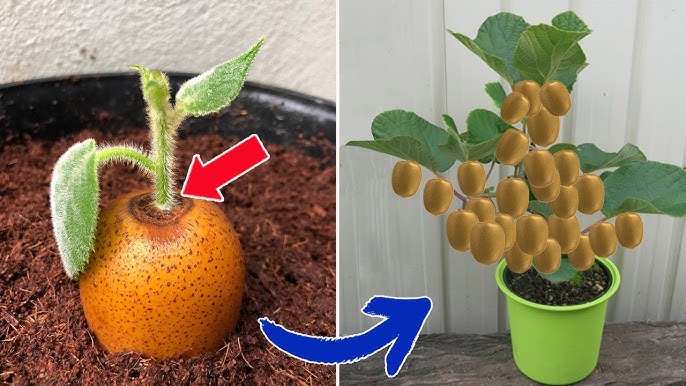Kiwi, known for its striking green interior and delightful sweet-tart taste, is a versatile fruit that you can grow right in your backyard. Whether you’re a seasoned gardener or a beginner, cultivating kiwi can be a fulfilling journey. Follow this step-by-step guide to successfully plant, care for, and harvest kiwi and enjoy the fruit of your labor!
1. Choosing the Right Kiwi Variety
Selecting the appropriate variety for your climate and space is key:
- Fuzzy Kiwi (Actinidia deliciosa): Larger fruits with a characteristic fuzzy skin. Best for mild climates.
- Hardy Kiwi (Actinidia arguta): Smaller fruits with smooth, edible skin. Perfect for cooler regions due to greater cold tolerance.
Opt for disease-free, vigorous plants from a reputable nursery. You may also need a male and female plant for pollination unless you choose a self-pollinating variety.
2. Site Selection and Soil Preparation
Kiwi vines thrive in well-drained soil and full sun. Follow these steps for the ideal setup:
- Soil: Ensure slightly acidic soil (pH 5.0-7.0). Perform a soil test and amend with sulfur (to lower pH) or lime (to raise pH) if needed. Add compost for fertility.
- Sunlight: Choose a location with 6-8 hours of daily sunlight.
- Space: Allow at least 10-15 feet between plants to accommodate their vigorous growth.
- Support Structures: Build sturdy trellises, arbors, or fences as kiwi vines can grow up to 20 feet tall.
3. Planting Kiwi
Here’s how to plant your kiwi vines properly:
- Dig a Hole: Ensure the hole is wide and deep enough to comfortably fit the root ball.
- Add Organic Matter: Mix compost or well-rotted manure into the planting hole for nutrient-rich soil.
- Position the Plant: Place the root ball in the hole, keeping the top level with the soil surface. Fill with soil, gently firming it to remove air pockets.
- Water and Mulch: Water thoroughly after planting and apply mulch around the base to retain moisture and regulate soil temperature.
4. Cultivating Kiwi
Proper care ensures healthy growth and abundant fruit production:
- Watering: Keep the soil consistently moist but not soggy. Deep watering is ideal during dry spells.
- Fertilizing: In spring, apply a balanced, slow-release fertilizer. Follow label instructions to avoid overfeeding.
- Pruning: Prune during the dormant season to shape the vine and remove dead or overcrowded branches. Regular pruning encourages new growth and maximizes fruit yield.
- Pests and Diseases: Watch for aphids, scale insects, and diseases like powdery mildew. Use organic pest control methods and maintain good air circulation to reduce disease risks.
5. Harvesting Kiwi
Kiwi fruit ripens between late summer and early fall. Here’s how to harvest them at the right time:
- Check Ripeness: A ripe kiwi will have vibrant green flesh and yield slightly when gently squeezed. Avoid picking when too hard.
- Taste Test: Sample a few fruits to confirm sweetness and flavor.
- Harvesting: Use pruning shears or scissors to carefully cut fruit clusters from the vine, avoiding damage to the plant.
Tips for Success
- Kiwi vines may take 3-5 years to produce fruit, so patience is key.
- Protect young vines from frost using covers during cold snaps.
- Keep the area weed-free and mulch regularly to suppress weeds and retain soil moisture.
Growing kiwi is a rewarding experience, yielding fresh, delicious fruit for your family. By choosing the right variety, preparing the soil, and dedicating consistent care, you’ll enjoy bountiful harvests season after season. With a little patience and effort, your garden will soon be bursting with vibrant kiwi vines and delectable fruit! 🌱🥝
